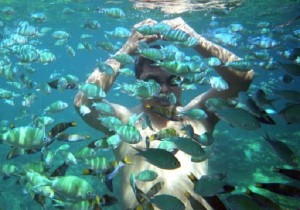‘Pyramids’ planted to revive corals off Boracay
MANILA, Philippines—Thousands of small “pyramids” are being planted off the Philippines’ famous Boracay resort island in an effort to bring its nearly destroyed coral reefs back to life, an environment group said Thursday.
Over 300 of the structures were planted this week off Boracay’s coast and eventually about 5,000 will be placed in the sea, according to Sangkalikasan (Nature) which is behind the effort.
“This is like putting garden soil for ideal growth on land. We are doing the same concept in the sea,” Jose Rodriguez, vice chairman of the group, told AFP.
Boracay, famed for its stunning white sand beach and clear waters, is one of the Philippines’ top tourist destinations with nearly one million people visiting the island last year.
But unsustainable development and the ever-growing number of tourists have caused severe environmental problems, including the destruction of the nearby reefs which often leave snorkellers looking at grey coral and few fish.
“My family has been coming to the island since the 1980s and we do see the drastic difference… (now) you only find the rubble of coral,” Rodriguez said.
He said divers had been planting the pyramid-shaped structures, called “reefbuds”, in about 7-9 meters (23-30 feet) of water up to 1,200 meters out to sea, and hoped to have all 5,000 in place in four months.
The reefbuds, which are about 70 centimeters (27 inches) tall, are not mere artificial reefs but will also serve as a medium for coral to grow back, according to Rodriguez.
Made of a combination of concrete, agricultural products and seawater, the hollow pyramids will initially serve as a breeding ground for algae and small fish.
But their porous walls are designed to allow coral to take root as well, so eventually they will give rise to an actual reef, said Sangkalikasan technical consultant Benjamin Tayag.
“You will first have soft corals, then hard corals but this will take years. Some hard corals grow only one centimeter a year,” he said.
The areas where the reefbuds are being planted will be declared off-limits to jet skis, boats that drop anchor and other forms of recreation that led to the initial damage, according to Tayag.
